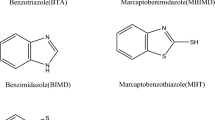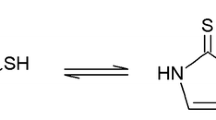Abstract
The aim of this study was to investigate electrochemical properties of brass in neutral and weakly alkaline solutions in the presence of cysteine as a nontoxic and ecological corrosion inhibitor. Potentiodynamic measurements, open circuit potential measurements, as well as chronoamperometric measurements were the methods used during investigation of the inhibitory effect of cysteine on the corrosion behaviour of brass. Potentiodynamic measurements showed that cysteine behaves as a mixed-type inhibitor in the investigated media. Based on polarization curves for brass in a weakly alkaline solution of sodium sulphate at varying cysteine concentrations, an interaction occurs between Cu+ ions and the inhibitor, resulting in the formation of a protective complex on the electrode surface. The results of chronoamperometric measurements confirm the results obtained by potentiodynamic measurements. Optical microphotography of the brass surface also confirms the formation of a protective film in the presence of a 1 × 10−4 mol/dm3 cysteine. Adsorption of cysteine on the brass surface proceeds according to the Langmuir adsorption isotherm.











Similar content being viewed by others
References
Ali I, Gupta VK (2007) Advances in water treatment by adsorption technology. Nat Protoc 1(6):2661–2667
Antonijević MM, Milić SM, Šerbula SM, Bogdanović GD (2005) The influence of chloride ions and benzotriazole on the corrosion behavior of Cu37Zn brass in alkaline medium. Electrochim Acta 50:3693–3701
Antonijevic MM, Alagic SC, Petrovic MB, Radovanovic MB, Stamenkovic AT (2009a) The influence of pH on electrochemical behavior of copper in presence of chloride ions. Int J Electrochem Sci 4:516–524
Antonijevic MM, Bogdanovic GD, Radovanovic MB, Petrovic MB, Stamenkovic AT (2009b) Influence of pH and chloride ions on electrochemical behavior of brass in alkaline solution. Int J Electrochem Sci 4:654–661
Antonijevic MM, Milic SM, Dimitrijevic MD, Petrovic MB, Radovanovic MB, Stamenkovic AT (2009c) The influence of pH and chlorides on electrochemical behavior of copper in the presence of benzotriazole. Int J Electrochem Sci 4:962–979
Antonijevic MM, Milic SM, Radovanovic MB, Petrovic MB, Stamenkovic AT (2009d) Influence of pH and chlorides on electrochemical behavior of brass in presence of benzotriazole. Int J Electrochem Sci 4:1719–1734
Assouli B, Ait Chikh ZA, Idrissi H, Srhiri A (2001) Electrosynthesis of adherent poly(2-mercaptobenzimidazole) films on brass prepared in nonaqueous solvents. Polymer 42:2449–2454
Badawy WA, El-Egamy SS, El-Azab AS (1995) The electrochemical behavior of leaded brass in neutral Cl- and SO -4 media. Corros Sci 37:1969–1979
Badawy WA, El-Egamy SS, Azab AS (1997) Investigation of corrosion and stability of lead–brass alloy in acid and neutral solutions using electrochemical impedance spectroscopy. Corrosion 53(11):842–851
Badawy WA, Ismail KM, Fathi AM (2006) Corrosion control of Cu–Ni alloys in neutral chloride solutions by amino acids. Electrochim Acta 51:4182–4189
Barouni K, Mihit M, Bazzi L, Salghi R, Al-Deyab SS, Hammouti B, Albourine A (2010) The inhibited effect of cysteine towards the corrosion of copper in nitric acid solution. Open Corros J 3:58–63
Bellakhal N, Draou K, Brisset JL (2002) Plasma and wet oxidation of (63Cu37Zn) brass. Mater Chem Phys 73:235–241
Elbakri M, Touir R, Ebn Touhami M, Srhiri A, Benmessaoud M (2008) Electrosynthesis of adherent poly(3-amino-1,2,3-triazole) films on brass prepared in nonaqueous solvents. Corros Sci 50:1538–1545
El-Deab MS (2011) Interaction of cysteine and copper ions on the surface of iron: EIS, polarization and XPS study. Mater Chem Phys 129:223–227
Fitzgerald KP, Nairn J, Atrens A (1998) The chemistry of copper patination. Corros Sci 40:2029–2050
Fu JJ, Li SN, Wang Y, Liu XD, Lu LD (2011) Computational and electrochemical studies on the inhibition of corrosion of mild steel by l-cysteine and its derivatives. J Mater Sci 46:3550–3559
Gupta VK, Ali I (2004) Removal of lead and chromium from wastewater using bagasse fly ash—a sugar industry waste. J Colloid Interf Sci 271:321–328
Gupta VK, Ali I (2008) Removal of endosulfan and methoxychlor from water on carbon slurry. Environ Sci Technol 42:766–770
Gupta VK, Rastogi A (2008) Biosorption of lead from aqueous solutions by green algae Spirogyra species: kinetics and equilibrium studies. J Hazard Mater 152:407–414
Gupta VK, Mohan D, Sharma S (1998) Removal of lead from wastewater using bagasse fly ash—a sugar industry waste material. Sep Sci Technol 33(9):1331–1343
Gupta VK, Gupta M, Sharma S (2001) Process development for the removal of lead and chromium from aqueous solutions using red mud—an aluminium industry waste. Wat Res 35(5):1125–1134
Gupta VK, Mangla R, Agarwal S (2002) Pb(II) selective potentriometric sensor based on 4-tert-butylcalix[4]arene in PVC matrix. Electroanal 14(15–16):1127–1132
Gupta VK, Mittal A, Gajbe V, Mittal J (2006a) Removal and recovery of the hazardous azo dye acid orange 7 through adsorption over waste materials: bottom ash and de-oiled soya. Ind Eng Chem Res 45:1446–1453
Gupta VK, Mittal A, Jain R, Mathur M, Sikarwar S (2006b) Adsorption of safranin-T from wastewater using waste materials—activated carbon and activated rice husks. J Colloid Interf Sci 303:80–86
Gupta VK, Mittal A, Kurup L, Mittal J (2006c) Adsorption of a hazardous dye, erythrosine, over hen feathers. J Colloid Interf Sci 304:52–57
Gupta VK, Singh AK, Gupta B (2007a) Schiff bases as cadmium(II) selective ionophores in polymeric membrane electrodes. Anal Chim Acta 583:340–348
Gupta VK, Ali I, Saini VK (2007b) Deflouridation of wastewaters using waste carbon slurry. Wat Res 41:3307–3316
Gupta VK, Ali I, Saini VK (2007c) Adsorption studies on the removal of Vertigo Blue 49 and Orange DNA 13 from aqueous solutions using carbon slurry developed from a waste material. J Colloid Interf Sci 315:87–93
Gupta VK, Jain R, Mittal A, Mathur M, Sikarwar S (2007d) Photochemical degradation of the hazardous dye safranin-T using TiO2 catalyst. J Colloid Interf Sci 309:464–469
Gupta VK, Jain R, Varshney S (2007e) Removal of Reactofix golden yellow 3 RFN from aqueous solution using wheat husk—an agricultural waste. J Hazard Mater 142:443–448
Gupta VK, Khayat MA, Singh AK, Pal MK (2009a) Nano level detection of Cd(II) using poly(vinyl chloride) based membranes of Schiff bases. Anal Chim Acta 634:36–43
Gupta VK, Goyal RN, Sharma RA (2009b) Novel PVC membrane based alizarin sensor and its application: determination of vanadium, zirconium and molybdenum. Int J Electrochem Sci 4:156–172
Gupta VK, Carrot PJM, Ribeiro Carrot MML, Suhas (2009c) Low-cost adsorbents: growing approach to wastewater treatment—a review. Crit Rev Env Sci Tec 39:783–842
Gupta VK, Rastogi A, Nayak A (2010) Adsorption studies on the removal of hexavalent chromium from aqueous solution using a low cost fertilizer industry waste material. J Colloid Interf Sci 342:135–141
Ismail KM (2007) Evaluation of cysteine as environmentally friendly corrosion inhibitor for copper in neutral and acidic chloride solutions. Electrochim Acta 52:7811–7819
Ismail KM, Elsherif RM, Badawy WA (2004a) Effect of Zn and Pb contents on the electrochemical behavior of brass alloys in chloride-free neutral sulfate solutions. Electrochim Acta 49:5151–5160
Ismail KM, Fathi AM, Badawy WA (2004b) The influence of Ni content on the stability of copper–nickel alloys in alkaline sulphate solutions. J Appl Electrochem 34:823–831
Jain AK, Gupta VK, Khurana U, Singh LP (1997) A new membrane sensor for UO 2+2 ions based on 2-hydroxyacetophenoneoxime-thiourea-trioxane resin. Electroanal 9(11):857–860
Kabasakaloğlu M, Kryak T, Şendil O, Asan A (2002) Electrochemical behavior of brass in 0.1M NaCl. Appl Surf Sci 193:167–174
Kear G, Barker BD, Walsh FC (2004) Electrochemical corrosion of unalloyed copper in chloride media—a critical review. Corros Sci 46:109–135
Kilinççeker G, Erbil M (2010) The effect of phosphate ions on the electrochemical behavior of brass in sulphate solutions. Mater Chem Phys 119:30–39
Matos JB, Pereira LP, Agostinho SML, Barcia OE, Cordeiro GGO, D’Elia E (2004) Effect of cysteine on the anodic dissolution of copper in sulfuric acid medium. J Electroanal Chem 570:91–94
Mihit M, El Issami S, Bouklah M, Bazzi L, Hammouti B, Ait AE, Salghi R, Kertit S (2006) The inhibited effect of some tetrazolic compounds towards the corrosion of brass in nitric acid solution. Appl Surf Sci 252:2389–2395
Milić SM, Antonijević MM, Šerbula SM, Bogdanović GD (2008) Influence of benzotriazole on corrosion behaviour of CuAlNiSi alloy in alkaline medium. Corros Eng Sci Techn 43(1):30–37
Milošev I, Mikić TK, Garbašček M (2006) The effect of Cu-rich sub-layer on the increased corrosion resistance of Cu–xZn alloys in chloride containing borate buffer. Electrochim Acta 52:415–426
Mokaddem M, Volovitch P, Ogle K (2010) The anodic dissolution of zinc and zinc alloys in alkaline solution. I. Oxide formation on electrogalvanized steel. Electrochim Acta 55:7867–7875
Morad MS (2005) Effect of amino acids containing sulfur on the corrosion of mild steel in phosphoric acid solutions containing Cl-, F- and Fe3+ ions: behavior under polarization conditions. J Appl Electrochem 35:889–895
Morad MSS, Hermas AEHA, Aal MSA (2002) Effect of amino acids containing sulfur on the corrosion of mild steel in phosphoric acid solutions polluted with Cl-, F- and Fe3+ ions-behaviour near and at the corrosion potential. J Chem Technol Biot 77:486–494
Oguzie EE, Li Y, Wang FH (2007) Effect of 2-amino-3-mercaptopropanoic acid (cysteine) on the corrosion behavior of low carbon steel in sulphuric acid. Electrochim Acta 53:909–914
Olivares O, Likhanova NV, Gómez B, Navarrete J, Llanos-Serrano ME, Arce E, Hallen JM (2006) Electrochemical and XPS studies of decylamides of α-amino acids adsorption on carbon steel in acidic environment. Appl Surf Sci 252:2894–2909
Otieno-Alego V, Hope GA, Notoya T, Schweinsberg DP (1996) An electrochemical and SERS study of the effect of 1-[N, N-bis-(hydroxyethyl)aminomethyl]-benzotriazole on the acid corrosion and dezinfication of 60/40 brass. Corros Sci 38:213–223
Quraishi MA, Farooqi IH, Saini PA (2000) Inhibition of dezinfication of 70-30 brass by aminoalkyl mercaptotriazoles. Brit Corros J 35(1):78–80
Ravichandran R, Rajendran N (2005) Influence of benzotriazole derivates on the dezinfication of 65-35 brass in sodium chloride. Appl Surf Sci 239:182–192
Ribotta SB, La Morgia LF, Gassa LM, Folque ME (2008) Characterization of anodic films formed on copper in 0.1M borax solution. J Electroanal Chem 624:262–268
Saifi H, Bernard MC, Joiret S, Rahmouni K, Takenouti H, Talhi B (2010) Corrosion inhibitive action of cysteine on Cu-30Ni alloy in aerated 0.5M H2SO4. Mater Chem Phys 120:661–669
Scendo M (2004) Corrosion inhibition of copper by purine or adenine in sulphate solutions. Corros Sci 49:3953–3968
Scendo M (2007a) The effect of purine on the corrosion of copper in chloride solutions. Corros Sci 49:373–390
Scendo M (2007b) Inhibitive action of the purine and adenine for copper corrosion in sulphate solutions. Corros Sci 49:2985–3000
Scendo M (2008) The influence of adenine on corrosion of copper in chloride solutions. Corros Sci 50:2070–2077
Srivastava SK, Gupta VK, Mohan D (1997) Removal of lead and chromium by activated Slag—a blast-furnace waste. J Environ Eng-ASCE 123(5):461–468
Tromans D, Sun RH (1992) Anodic behaviour of copper in weakly alkaline solutions. J Electrochem Soc 139:1945–1951
Ye XR, Xin XQ, Zhu JJ, Xue ZL (1998) Coordination compound films of 1-phenyl-5-mercaptotetrazole on copper surface. Appl Surf Sci 135:307–317
Zarrouk A, Hammouti B, Zarrok H, Al-Deyab SS, Messali M (2011a) Temperature effect, activation energies and thermodynamic adsorption studies of l-cysteine methyl ester hydrochloride as copper corrosion inhibitor in nitric acid 2M. Int J Electrochem sci 6:6261–6274
Zarrouk A, Hammouti B, Dafali A, Zarrok H (2011b) L-cysteine methyl ester hydrochloride: a new corrosion inhibitor for copper in nitric acid. Der Pharma Chim 3(4):266–274
Zhang DQ, Gao LX, Zhou GD (2005) Inhibition of copper corrosion in aerated hydrochloric acid solution by amino-acid compounds. J Appl Electrochem 35:1081–1085
Zhang DQ, Cai QR, He XM, Gao LH, Zhou GD (2008) Inhibition effect of some amino acids on copper corrosion in HCl solution. Mater Chem Phys 112:353–358
Acknowledgements
The authors gratefully acknowledge the financial support of the Ministry of Education and Science of Republic of Serbia through the Project No 172031.
Author information
Authors and Affiliations
Corresponding author
Additional information
Responsible editor: Vinod Kumar Gupta
Rights and permissions
About this article
Cite this article
Radovanović, M.B., Petrović, M.B., Simonović, A.T. et al. Cysteine as a green corrosion inhibitor for Cu37Zn brass in neutral and weakly alkaline sulphate solutions. Environ Sci Pollut Res 20, 4370–4381 (2013). https://doi.org/10.1007/s11356-012-1088-5
Received:
Accepted:
Published:
Issue Date:
DOI: https://doi.org/10.1007/s11356-012-1088-5




